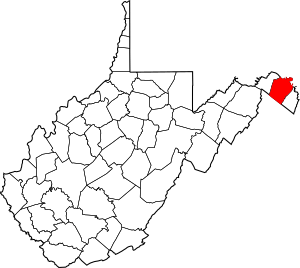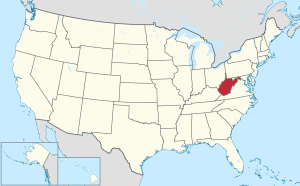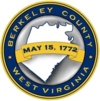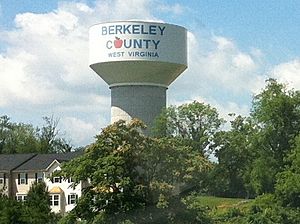Berkeley County, West Virginia facts for kids
Quick facts for kids
Berkeley County
|
||
|---|---|---|
|
Berkeley County Courthouse
Adam Stephen House
Hedgesville Historic District
Sleepy Creek Wildlife Management Area
|
||
|
||

Location of Berkeley County in West Virginia
|
||

West Virginia's location within the U.S.
|
||
| Country | ||
| State | ||
| Founded | May 15, 1772 | |
| Seat | Martinsburg | |
| and largest city | ||
| Area | ||
| • Total | 832.8 km2 (321.56 sq mi) | |
| • Land | 831.8 km2 (321.15 sq mi) | |
| • Water | 1.1 km2 (0.41 sq mi) 0.5% | |
| Area rank | 40th | |
| Population
(2020)
|
||
| • Total | 122,076 | |
| • Estimate
(2021)
|
126,069 |
|
| • Rank | 2nd | |
| • Density | 146.77/km2 (380.12/sq mi) | |
| Time zone | UTC−5 (Eastern) | |
| • Summer (DST) | UTC−4 (EDT) | |
| Area code(s) | 304, 681 | |
| Congressional district | 2nd | |
| Senate districts | 15th, 16th | |
| House of Delegates districts | 90th-97th | |
| Website | http://www.berkeleywv.org/ | |
Berkeley County is located in the Shenandoah Valley in the eastern panhandle region of West Virginia in the United States. The county is part of the Hagerstown–Martinsburg metropolitan area. As of the 2020 census, the county population was 122,076, making it the second-most populous of West Virginia's 55 counties, behind Kanawha County. The City of Martinsburg is the county seat.
History
Created on May 15, 1772, by an act of the House of Burgesses from the northern third of Frederick County when it was part of Virginia, Berkeley County went on to become West Virginia's second-oldest county after that state seceded from Virginia in 1863 during the Civil War. At the time of the county's formation, Berkeley County comprised areas that now are part of present-day Jefferson and Morgan counties in West Virginia.
Most historians believe the county was named for Norborne Berkeley, Baron de Botetourt (1718–1770), Colonial Governor of Virginia from 1768 to 1770. West Virginia's Blue Book, for example, indicates Berkeley County was named in his honor. He served as a colonel in England's North Gloucestershire militia in 1761, and represented that division of the county in Parliament until he was made a peer in 1764. Having incurred heavy gambling debts, he solicited a government appointment and in July 1768 was made Governor of Virginia. In 1769, he reluctantly dissolved the House of Burgesses after it adopted resolutions that opposed Parliament's replacement of requisitions with parliamentary taxes as a means of generating revenue and a requirement for accused American criminals to be sent to England for trial.
Despite his differences with the House of Burgesses, Berkeley was well respected by the colonists, especially after he sent Parliament letters encouraging them to repeal the taxes. When Parliament refused to rescind them, Governor Berkeley requested to be recalled. In appreciation of his efforts, the colonists erected a monument to his memory in Williamsburg, and two counties were later named in his honor: Berkeley in present-day West Virginia and Botetourt in Virginia.
Other historians claim Berkeley County may have been named in honor of Sir William Berkeley (1610–1677), who was born near London, graduated from Oxford University in 1629 and was appointed Governor of Virginia in 1642. He served as Governor until 1652 and was reappointed Governor in 1660. Berkeley presided over the colony during Bacon’s Rebellion of 1676, and was called back to England the following year.
Early settlers
According to missionary reports, several thousand Hurons occupied present-day West Virginia, including the eastern panhandle region, during the late 16th and early 17th centuries. During the 17th century, the Iroquois Confederacy (then consisting of the Mohawk, Onondaga, Cayuga, Oneida, and Seneca tribes) drove the Hurons from the state. The Iroquois Confederacy was headquartered in New York and was not interested in occupying present-day West Virginia. Instead, they used it as a hunting ground during the spring and summer months.
During the early 18th century, West Virginia's eastern panhandle region was inhabited by the Tuscarora. They eventually migrated northward into New York and, in 1712, became the sixth nation formally admitted into the Iroquois Confederacy. The eastern panhandle region was also used as a hunting ground by several other Indian tribes, including the Shawnee (then known as the Shawanese) who resided near present-day Winchester, Virginia and Moorefield, West Virginia until 1754 when they migrated into Ohio. The Mingo, who resided in the Tygart Valley and along the Ohio River in present-day West Virginia's northern panhandle region, and the Delaware, who lived in present-day eastern Pennsylvania, New Jersey and Delaware, but had several autonomous settlements as far south as present-day Braxton County, also used the area as a hunting ground.
Following the French and Indian War, the Mingo retreated to their homes along the banks of the Ohio River and were rarely seen in the eastern panhandle region. Although the French and Indian War was over, many Indians continued to view the British as a threat to their sovereignty and continued to fight them. In the summer of 1763, Pontiac, an Ottawa chief, led raids on key British forts in the Great Lakes region. Shawnee chief Keigh-tugh-qua, also known as Cornstalk, led similar attacks on western Virginia settlements, starting with attacks in present-day Greenbrier County and extending northward to Berkeley Springs, and into the northern Shenandoah Valley. By the end of July, Indians had destroyed or captured all British forts west of the Alleghenies except Fort Detroit, Fort Pitt, and Fort Niagara. The uprisings were ended on August 6, 1763, when British forces, under the command of Colonel Henry Bouquet, defeated Delaware and Shawnee forces at Bushy Run in western Pennsylvania.
During the American Revolutionary War (1775–1783), the Mingo and Shawnee, headquartered at Chillicothe, allied themselves with the British. In 1777, a party of 350 Wyandots, Shawnees, and Mingos, armed by the British, attacked Fort Henry, near present-day Wheeling. Nearly half of the soldiers manning the fort were killed in the three-day assault. The Indians then left the area celebrating their victory. For the remainder of the war, smaller raiding parties of Mingo, Shawnee, and other Indian tribes repelled settlers throughout northern and eastern West Virginia. As a result, European settlement throughout present-day West Virginia, including the eastern panhandle, came to a virtual standstill until the war's conclusion.
Following the war, the Mingo and Shawnee, once again allied with the losing side, returned to their homes. As the number of settlers in present-day West Virginia began to grow, both the Mingo and Shawnee moved further inland, leaving their traditional hunting ground to the white settlers.
17th-century European explorers
In 1670, John Lederer, a German physician and explorer employed by Sir William Berkeley, colonial governor of Virginia, became the first European to set foot in present-day Berkeley County; their safety was not guaranteed. John Howard and his son also passed through present-day Berkeley County a few years later, and discovered the valley of the South Branch Potomac River at Green Spring.
The 18th century
The next known explorer to traverse the county was John Van Meter (1683–1745) in the 1730s. He came across the Potomac River, at what is now known as Shepherdstown, then he made his way to the South Branch Potomac River. In 1726, Morgan Morgan moved from Delaware and founded the first permanent English settlement of record in West Virginia on Mill Creek near the present-day Bunker Hill in Berkeley County. The state of West Virginia erected a monument in Bunker Hill commemorating the event, and placed a marker at Morgan's grave, which is located in a cemetery near the park. Morgan Morgan and his wife, Catherine Garretson, had eight children. His son, Zackquill Morgan, later founded present-day Morgantown.
In 1730, John Van Meter, with his brother Isaac (1692–1757), secured a patent for 40,000 acres (160 km2) at the South Branch Potomac River, much of it in present-day Berkeley County, from Virginia's Colonial Lieutenant Governor William Gooch. Part of the land was sold the following year to Hans Yost Heydt, also known as Joist Hite or Jost Hite. In 1732, Heydt (Hite) and fifteen families set out from York, Pennsylvania, passed through present-day Berkeley County, and settled near present-day Winchester, Virginia. In 1744, Isaac Van Meter moved to a site near Moorefield — then part of Hampshire County, but now in Hardy County (see Fort Pleasant) — where he was later killed by Indians. (His brother John settled and died in Winchester, Virginia.)
In 1748, George Washington, then just sixteen years old, surveyed present-day Berkeley County for Thomas Fairfax, 6th Lord Fairfax of Cameron. He later returned to Bath (Berkeley Springs), West Virginia several times over the next several years with his half-brother, Lawrence, who was ill and hoped that the warm springs might improve his health. The springs, and their rumored medicinal benefits, attracted numerous Native Americans as well as Europeans to the area.
The 19th century
Berkeley County was reduced in size twice during the 19th century. On January 8, 1801, Jefferson County was formed out of the county's eastern section. Then, on February 9, 1820, Morgan County was formed out of the county's western section and parts of Hampshire County.
Berkeley County was strategically important to both the North and the South during the American Civil War (from 1861 to 1865). The county, and Martinsburg, its seat, lay at the northern edge of the Shenandoah Valley, and Martinsburg was important because the main line of the Baltimore and Ohio Railroad ran through it. The B&O was valuable to both armies for moving men and materiel. Increasing Martinsburg's strategic value was its proximity to the United States Arsenal and Armory at Harpers Ferry. Control over Martinsburg changed hands many times during the war, especially prior to the Battle of Gettysburg in July 1863. After Gettysburg, the city remained mostly under Union control.
About 75% of Berkeley County's residents were loyal to the South during the American Civil War. Confederate fervor was even more evident with military enlistment, at least about 80% of soldiers fought for the South. There were at least eleven companies of soldiers recruited from the county: at least nine for the Confederate Army but only two for the Union Army. In addition, the local militia sided with the Confederacy.
The Confederate units consisted of the following: Chew's Battery Virginia Horse Artillery (a.k.a. Capt. James W. Thomson's & Capt. John W. Carter's Co.), Capt. Osmond B. Taylor's Co. Virginia Light Artillery, Wise Artillery (Co. B, 1st Regiment Virginia Light Artillery), Co. F Clark's Co (12th Virginia Cavalry), Co. A Wildcat Cavalry (11th Virginia Cavalry), Co. B Berkeley Troop (1st Virginia Cavalry), Co. F Shepherdstown Troop (1st Virginia Cavalry), Co. D Berkeley Border Guards (2nd Virginia Infantry), Co. E Hedgesville Blues (2nd Virginia Infantry), and 67th Regiment Virginia Militia. It is also believed that soldiers from Berkeley County participated in other Confederate units as well, such as the 7th Virginia Cavalry, whose Co. F and G recruited out of neighboring Hampshire and Jefferson Counties
The Union units consisted of Co. C 3rd Regiment, West Virginia Cavalry, and Company B First Regiment, (West) Virginia Volunteers.
Yet it was (then-Colonel) Stonewall Jackson who wrote to Robert E. Lee, "... I regret to say that in Berkeley things are growing worse, and that the threats from Union men are calculated to curb the expression of Southern feeling."
A member of the Stonewall Brigade also wrote, "We left Winchester the first of this week [in June, 1861] and came to Berkeley County, the meanest Abolition hole on the face of the earth, Martinsburg especially."
At least six hundred men from Berkeley County served in either the Confederate Army or the Union Army. When the vote for separation from Confederate Virginia was held, the majority voted for the Union creation of the state of West Virginia.
Berkeley County was also the home of Maria Isabella "Belle" Boyd, a famous spy for the Confederacy.
Joining West Virginia
During the American Civil War (1861–1865), Berkeley and Jefferson counties, both lying on the Potomac River east of the mountains, with the consent of the Reorganized Government of Virginia, voted in favor of annexation to West Virginia in 1863. The occupying Federal troops in the area ensured the desired outcome. Many voters absent in the Confederate Army when the vote was taken refused to acknowledge the transfer upon their return. The Virginia General Assembly repealed the Act of Secession and in 1866 brought suit against West Virginia, asking the court to declare the counties a part of Virginia. Meanwhile, Congress, on March 10, 1866, passed a joint resolution recognizing the transfer. In 1871, the U.S. Supreme Court decided Virginia v. West Virginia, upholding the secession of West Virginia, including Berkeley and Jefferson counties, from Virginia.
In 1863, West Virginia's counties were divided into civil townships, with the intention of encouraging local government. This proved impractical in the heavily rural state, and in 1872 the townships were converted into magisterial districts. Berkeley County was divided into seven districts: Arden, Falling Waters, Gerrardstown, Hedgesville, Martinsburg, Mill Creek, and Opequon. The town of Martinsburg was originally co-extensive with Martinsburg District, but later spread into adjoining districts. Between 1990 and 2000, Berkeley County was redivided into six magisterial districts: Adam Stephens, Norborne, Potomac, Shenandoah, Tuscarora, and Valley.
Geography
According to the United States Census Bureau, the county has a total area of 322 square miles (830 km2), of which 321 square miles (830 km2) is land and 0.4 square miles (1.0 km2) (0.1%) is water.
Mountains and hills
- Third Hill Mountain – highest and most topographically prominent peak in the county
Rivers and streams
- Potomac River
- Back Creek
- Tilhance Creek
- Cherry Run
- Meadow Branch (tributary of Sleepy Creek in Morgan County)
- Opequon Creek
- Middle Creek
- Mill Creek
- Tuscarora Creek
Agricultural land and conservation easements
As of 2017, Berkeley County had 53 farmland easements which place permanent restrictions on development, covering 5,133 acres of land, according to the Berkeley County Farmland Protection Board.
Major highways
 I‑81
I‑81 US 11
US 11 WV 9
WV 9 WV 45
WV 45 WV 51
WV 51 WV 115
WV 115 WV 901
WV 901
Adjacent counties
- Washington County, Maryland (north)
- Jefferson County (southeast)
- Frederick County, Virginia (south)
- Morgan County (northwest)
Demographics
| Historical population | |||
|---|---|---|---|
| Census | Pop. | %± | |
| 1790 | 19,713 | — | |
| 1800 | 22,006 | 11.6% | |
| 1810 | 11,479 | −47.8% | |
| 1820 | 11,211 | −2.3% | |
| 1830 | 10,518 | −6.2% | |
| 1840 | 10,972 | 4.3% | |
| 1850 | 11,771 | 7.3% | |
| 1860 | 12,525 | 6.4% | |
| 1870 | 14,900 | 19.0% | |
| 1880 | 17,380 | 16.6% | |
| 1890 | 18,702 | 7.6% | |
| 1900 | 19,469 | 4.1% | |
| 1910 | 21,999 | 13.0% | |
| 1920 | 24,554 | 11.6% | |
| 1930 | 28,030 | 14.2% | |
| 1940 | 29,016 | 3.5% | |
| 1950 | 30,359 | 4.6% | |
| 1960 | 33,791 | 11.3% | |
| 1970 | 36,356 | 7.6% | |
| 1980 | 46,846 | 28.9% | |
| 1990 | 59,253 | 26.5% | |
| 2000 | 75,905 | 28.1% | |
| 2010 | 104,169 | 37.2% | |
| 2020 | 122,076 | 17.2% | |
| 2022 (est.) | 129,490 | 24.3% | |
| U.S. Decennial Census 1790–1960 1900–1990 1990–2000 2010–2020 |
|||
2020 census
As of the 2020 census, there were 122,076 people and 50,841 households residing in the county. There were 50,868 housing units in Berkeley. The racial makeup of the county was 80.5% White, 7.7% African American, 1.2% Asian, 0.3% Native American, 2.3% from other races, and 8% from two or more races. Hispanics or Latinos of any race were 5.6% of the population.
Of the 50,841 households, 48.6% were married couples living together, 23.5% had a female householder with no spouse present, 17.6% had a male householder with no spouse present. The average household and family size was 2.96. The median age in the county was 38.5 years with 22.9% of the population under 18. The median income for a household was $71,733 and the poverty rate was 9.2%.
2010 census
As of the 2010 United States Census, there were 104,169 people, 39,855 households, and 27,881 families residing in the county. The population density was 324.4 people per square mile (125.3 people/km2). There were 44,762 housing units at an average density of 139.4 units per square mile (53.8 units/km2). The racial makeup of the county was 87.8% white, 7.1% black or African American, 0.8% Asian, 0.3% American Indian, 1.2% from other races, and 2.6% from two or more races. Those of Hispanic or Latino origin made up 3.8% of the population. In terms of ancestry, 27.0% were German, 14.8% were Irish, 12.3% were English, 10.2% were American, and 5.1% were Italian.
Of the 39,855 households, 35.7% had children under the age of 18 living with them, 52.3% were married couples living together, 12.0% had a female householder with no husband present, 30.0% were non-families, and 23.4% of all households were made up of individuals. The average household size was 2.59 and the average family size was 3.04. The median age was 37.6 years.
The median income for a household in the county was $52,857 and the median income for a family was $64,001. Males had a median income of $45,654 versus $34,239 for females. The per capita income for the county was $25,460. About 7.0% of families and 10.1% of the population were below the poverty line, including 13.2% of those under age 18 and 6.5% of those age 65 or over.
Communities
City
- Martinsburg (county seat)
Town
Census-designated places
Unincorporated communities
- Allensville
- Arden
- Baker Heights
- Baxter
- Bedington
- Berkeley
- Bessemer
- Blairton
- Bunker Hill
- Darkesville
- Douglas Grove
- Files Crossroad
- Ganotown
- Georgetown
- Gerrardstown
- Glengary
- Greensburg
- Grubbs Corner
- Hainesville
- Johnsontown
- Jones Springs
- Little Georgetown
- Marlowe
- Nipetown
- Nollville
- North Mountain
- Pikeside
- Ridgeway
- Scrabble
- Shanghai
- Spring Mills
- Swan Pond
- Tablers Station
- Tarico Heights
- Tomahawk
- Union Corner
- Van Clevesville
- Vanville
- Winebrenners Crossroad
- Wynkoop Spring
Magisterial districts
- Adam Stephen
- Norborne
- Potomac
- Shenandoah
- Tuscarora
- Valley
Notable people
- Victoria "Vicky" Bullett, former professional women's basketball player, member of the 1988 and 1992 U.S. Olympic Teams that won gold and bronze medals respectively.
- Christopher Martinka, an award-winning Scottish-American documentary photographer.
- Thomas Hinds (1780–1840), a military hero of the War of 1812, US Congressman, and namesake of Hinds County, Mississippi.
- William Robinson Leigh (1866–1955), an American artist who specialized in Western scenes, was born at Maidstone Manor.
- Christian Lopez (born 1995), an American singer-songwriter and multi-instrumentalist.
See also
 In Spanish: Condado de Berkeley (Virginia Occidental) para niños
In Spanish: Condado de Berkeley (Virginia Occidental) para niños









